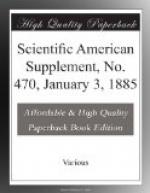I am satisfied that in many cases first-class varnish has to bear the odium, when the root of the evil is to be found nearer the foundation. The leading varnish manufacturers of this country have expended large fortunes to secure the best skill and appliances, and, indeed, to do everything to bring their goods to perfection. Their standing and respectability put them beyond suspicion, and their reputation is of too much value for them knowingly to put into the hands of large consumers an inferior article; and even when we have just cause to complain of the varnish, we ought to be charitable enough to attribute the mistake to circumstances beyond their control (for every kettleful is subjected to such circumstances), and not to charge them with using cheap or inferior material for the sake of gain.
If the question which has been given me means to give some method of testing before using, I confess my inability to answer. For varnish to be pronounced “durable” must be composed of the materials to make it so, and to ascertain this, chemistry must be called in to test it. Comparatively few painters understand chemistry sufficiently to analyze, and if they did, and found the material all that is necessary, the manipulation may have been defective, so as to injure its wearing qualities, and therefore I cannot suggest any way of pronouncing varnish durable before using it.
As to the common custom of hanging out boards prepared and varnished to the exposure of the sun and weather for months does not seem to me to be the correct way of testing durability. It is true we may by this mode get some idea of wearing properties, but the most thorough and correct way is to put the varnish to the same exposure, the tear and wear, that it would have in the regular service on the road on which it is to run. Cars while running are exposed to circumstances which boards on the wall are not subjected to. The cars under my charge run through two different countries and three different States, and therefore subjected to such a variety of climate and soil that the testing by stationary boards would completely fail to give the correct result. For example:




